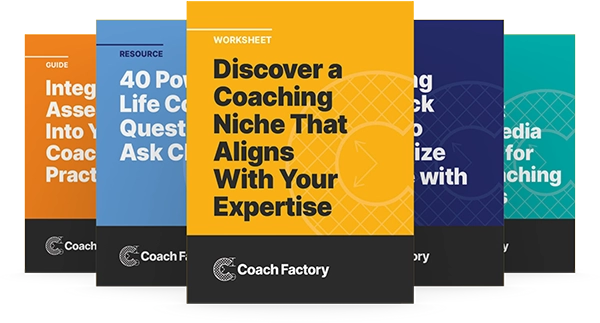After years of offering 1:1 client sessions, you’re finally ready to offer a group coaching program. This might be due to the stress of juggling many clients at different times. Or, you’ve noticed that many of your clients have similar issues and could benefit from learning in a group dynamic.
You likely have success with your single sessions but having a group coaching program can:
- Free up your work schedule and reduce your daily responsibilities
- Present the opportunity to impact and help more people with your specialized coaching
- Provide an extra stream of income without an increase in workload
But how will I get people to sign up? Who are these people? What about pricing?
During a recent chat, coaching experts Milana Leshinsky and Jennifer Bourn shared a few tips to guide coaches in maximizing a group coaching program.
Here’s what they had to say.
1. Defining your group size matters
The first step in starting a group coaching program is to define a comfortable group size. For some, a small group of five people is enough, while others may be perfectly comfortable with a larger group.
“Technically, two people are a group. But honestly, I don’t think that it would be worth my time, my effort, my energy to run a group of two people. So, I always like to get at least 12, but I’ve run group programs as large as 306.”
– Milana Leshinsky, Coaching Genie
For most coaches who are just starting with group coaching, Jennifer and Milana both agree that 6-12 participants is ideal.
2. Structure comes before the sale
Pre-selling is a popular technique used to market and fill group coaching programs but it’s not without its shortcomings. First, it’s harder to sell something that isn’t created yet. Building as you go can help you get up and running more quickly, but you’ll soon find that your program is lacking key elements or there are gaps in the messaging. This is because coaching is inherently an intimate experience. It requires careful planning to ensure the transformation you’re offering is truly what your clients want.
This is why it’s important to get clear on what you want to offer the participants of your program. For this step, Milana recommends investing in a coaching platform, like Coaching Genie, to assist you in mapping out your offer.
For Jennifer, simple sales pages are her go-to for getting crystal clear on her offers. It also helped her fill a $12k coaching program.
To those of you who aren’t sales page-savvy, we’re not talking about a beautifully designed, Amy Porterfield-esque sales page. Jennifer’s advice is to keep it simple by focusing more on the message and your audience.
“It’s not about having the prettiest, most perfect sales page. It’s about the message. The copy has to connect deeply with somebody in their core and for them to say, ‘I want that. I need that. I want to be a part of that. I don’t want to miss out on that opportunity. I want to be in the room with those people.’ and that’s more powerful than anything.”
– Jennifer Bourn
Remember to prioritize effectiveness over fancy design when creating a sales page because your message should be the most important thing your audience notices.
3. An engaged list of potential participants is better than a big list
The only thing that matters as much as the content of your program is the work you do before launching your program. Your marketing and branding is what attracts people to you and your expertise. When you’re actively building a list, you’re also building relationships with people and gaining their trust.
While we can’t deny having a massive contact list is helpful for filling your program, we can confirm that it’s not always necessary. Especially if your list is less likely to engage. Having a small, intentionally curated list is more valuable.
“The bigger your list is, the less you know each individual on that list. The connection, the relationship between you and the people on your list now has some distance. I would rather have a tight list of the right people.”
– Jennifer Bourn
The key takeaway here is to press forward with launching your group coaching program even if you have a small list.
4. Be transparent with pricing and use testimonials to attract more participants
High-ticket offers require a great deal of transparency because you never want to waste anyone’s time. The practice of withholding your pricing until after conversation, can make potential clients feel uncomfortable and reluctant to buy your offer.
Milana shares her successful experience of filling a $2000 program every year. Her secret: put the price on the sales page and sell it directly, without the need for a conversation or application process. She’s also received numerous testimonials from satisfied clients who initially had hesitations about the price, but found great value in the program.
Testimonials also pay a key role in helping others see the value in your group coaching program. You know what you have to offer, but who else knows and are they willing to tell others about it?
Great testimonials give your program legs to stand on its own without needing you for the support. Instead, you can allow other people to give their perspective and experience with your program — particularly the impact it’s had on them. This is far more effective and helps potential clients better visualize their transformation.
5. Create meaningful scarcity and genuine urgency
We’ve all seen the ‘only 2 spots left and your opportunity is gone forever’ marketing tactic, only to find out weeks later that the program is evergreen. A false sense of scarcity and urgency is misleading, dishonest, and insulting to potential participants.
Creating scarcity and urgency are critical for motivating people to sign up for your program, but not at the expense of risking the trust they have in you.
One effective method for creating urgency is to leverage your personal and work schedule. For example, open registration for your program in the week leading up to your next work trip or vacation. In your offer, emphasize that you won’t be available to answer any inquiries in the following week due to travel. You’ll create the much-needed scarcity and urgency to encourage sign ups without faking it.
Another method is to add bonuses for early birds to give them a reason to hop on your offer as soon as possible. This could be arranging a special Q&A before the start of the program, adding bonus materials, or even inviting special guests in for an exclusive chat.
It requires more creativity, but prompting sign ups without breaking the trust with potential clients is a sure way to fill your program.
Coaching Conversations for Growth
This conversation between Milana and Jennifer highlights the importance of trust, transparency, personal connection, and effective messaging when building a group coaching program. Launching a group coaching program calls for coaches to analyze what they want to offer and use their ability to read the room to tailor their offer to those who most desire it.
Want to learn more?
Listen to the entire conversation here, or subscribe to the Coaching Genie channel on YouTube and hear from experts once a month to grow your practice and find answers to your most pressing — and sometimes controversial — coaching questions.


